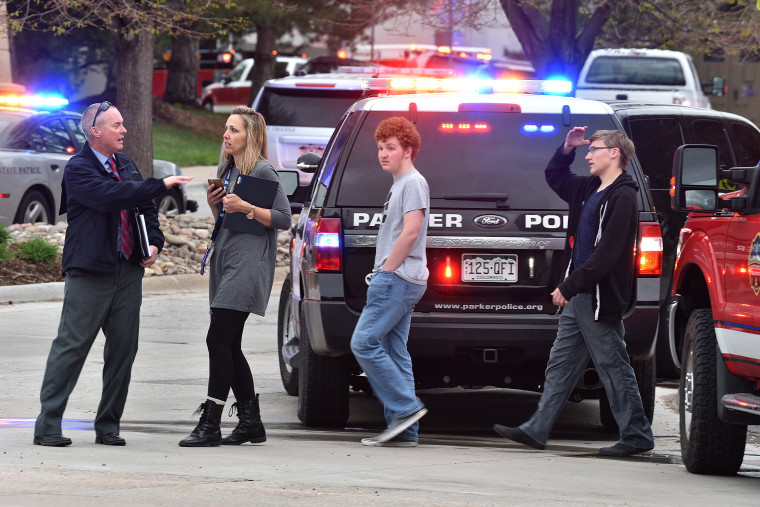HIGHLANDS RANCH, Colo. — In the race to protect American students from shootings, one of the simplest and most affordable upgrades authorities can make is to put a two-way police radio inside every school, experts say.
The connection allows school staff to broadcast an emergency directly to police.
Relatively few schools have one, however.
Among the exceptions is STEM School Highlands Ranch outside Denver, where a pair of armed students opened fire on Tuesday, killing one person and injuring eight others. Police arrived less than two minutes after reports of gunfire, immediately taking one of the attackers into custody. The speed of the response was due in large part to the radio link, Douglas County Sheriff Tony Spurlock told NBC News.
"They have one of our radios and they have communication directly to a dispatch center and they immediately notified us that there was an active shooter in the school," Spurlock said Wednesday. "That went over all of our comms so everyone was able to hear it immediately. That saves minutes to notify people."
In active shootings, every moment counts: Research has showed that such attacks typically last four to six minutes. That is why police are now trained to enter a scene immediately, even if they are alone ─ a lesson from the 1999 shooting at Columbine High School, when police waited 45 minutes to prepare a tactical unit while students rampaged through the building, killing 13 people and themselves.
Clear and direct communications can also speed response, getting officers to the scene quickly and helping them know where to go once they arrive, authorities say. Experts point to another massacre, at Marjory Stoneman Douglas High School in Parkland, Florida, where poor radio communication contributed to a slow police response. A former student killed 17 people in the Feb. 14, 2018 attack.
Curtis Lavarello, executive director of the School Safety Advocacy Council, which helps school districts develop security plans, said he has advised more than 1,000 school agencies in the last five years and less than 10 percent had direct two-way radio links to local police.
"Typically in law enforcement we’re protective of our stuff, our toys, radio communications even more so," Lavarello said. "In assessments, we tell them to try to bring down that wall, because if you can narrow the time on communications, that's key."
The switch can be as simple as distributing unused police radios to schools or adding police channels to existing school radios, he said.
On Tuesday, among the first officers to arrive at STEM School Highlands Ranch was a lieutenant who runs Douglas County's school resource officer program, Spurlock said. The charter school did not have its own school resource officer, but the lieutenant evidently knew the building well enough to pick open a side door. She immediately encountered one of the shooters in a hallway, Spurlock said.
More officers poured into the school as they arrived, many of them rushing from a police substation four blocks away, he said.
It took another five minutes or so ─ "it seemed like an eternity to me," Spurlock said ─ for officers to find the second shooter in a classroom and take that person into custody.
The attack was also likely cut short by a group of students who rushed one of the shooters, according to witnesses. One of those students, Kendrick Castillo, 18, died.
"I believe those things made a huge difference in saving lives," Spurlock said.

